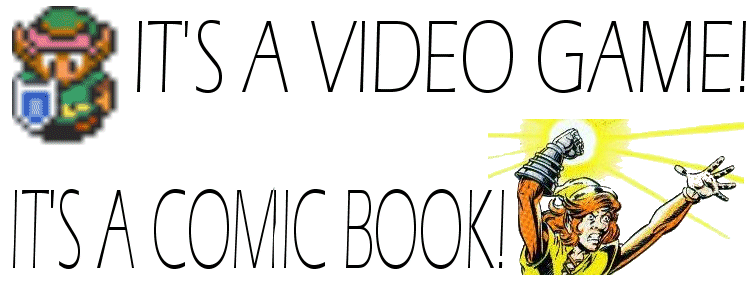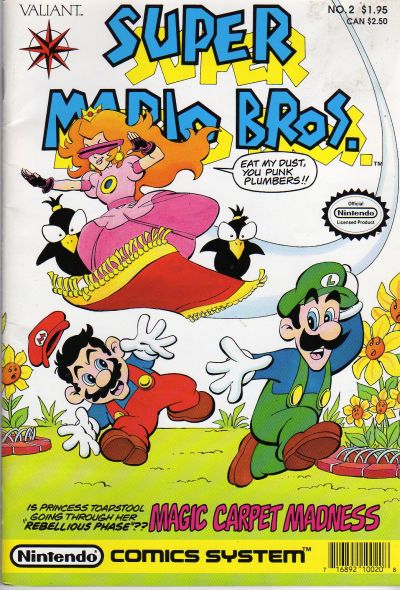

Licensed-property comic books don't happen as often as they used to. It's not that no one wants to pull the old "buy something that's already popular instead of creating something original" scheme anymore, it's just because comics aren't as profitable as they used to be. But there have already been many examples of video games turned into comic books--some good, some decent, some wretched. Today we look at three.
| The runaway success of the Nintendo
Entertainment System led to the Nintendo Cereal System,
the Nintendo TV Cartoon System, the Nintendo Happy Meal
System, the Nintendo Wastebasket System and many many
other such products. By the time the Nintendo Comics
System came out in 1991, the market for Mario pajamas was
starting to cool. The line didn't sell very well, with
each title getting four or five issues apiece before
getting shoved as one into a Comics System
"compilation title" where the remaining
completed stories were burned off. The Nintendo Comics System, in its brief existence, encompassed Super Mario Bros, Zelda and Captain N comics, as well as a comic revolving around Game Boy (somehow). As you've already pieced together from the placement of that cover, we'll be taking a look at the Zelda comic. |
| "The Legend of Zelda" was
loosely based on the evil cartoon and ran a span of 4 1/2
issues. One major difference between TV cartoons and the
comics they inspire is that while a TV show has to play
it safe and can't play all its cards at once if it wants
to survive, a comic book has to hit the ground running
and please the fans as much as possible, or its time of
existence will be much shorter. So while TV Link had a lot of trouble pestering signs of affection out of Zelda, here they can barely keep their hands off each other. Yet she still won't kiss him, which now looks even weirder. |
| But not as weird as this looks. Since this is pre-Link to the Past material, all characters are inspired by their original instruction manual drawings. In Zelda II Link had a protruding Jughead nose, and the comic kept that nose for its entire run despite how impossible it makes certain scenes look. Yeah yeah, beauty's only skin deep, but...he's hideous. How can anyone look past a honker like that? |
The nose looked even worse when
cover artists tried to depict Link "realistically."
ISSUE #1: Here's another prime example of a comic book fighting from Panel 1 to keep its audience, as "The Legend of Zelda" opens with a depiction of Ganon taking over Hyrule and towering defiantly over a frightened townspeople and a dead Link. Of course they say Link is "doomed" instead; the Nintendo Comics System had a weird policy regarding words that mean death. "Die" was sometimes allowed but "Kill" wasn't; the dialogue often substituted "destroy" instead.
"HE ALSO SERVES": The Triforce of Wisdom has predicted Link must not leave the castle today, no matter what. Or else....Ganon will rule, guaranteed! "Okay," says Link, "I won't leave the castle!" This decision becomes more and more difficult to stand by as visitor after visitor barges through the gates telling panicked tales of Ganon wiping out villages and capturing Zelda again. But Link sticks by his original decision, and it was a good thing, because Ganon himself was posing as all those people to get Link to step outside. It turned out this was the one day when the planets were aligned in such a way that Ganon's minions could fire a magic blast powerful enough to kill Link in one shot. Yay, Link's still alive, onto the next story.
"MISSING IN ACTION": Zelda's the one who's missing; she's run away from Hyrule forever because she's decided her Triforce of Wisdom is no longer safe while Ganon's around. Link catches up with her and tries to convince her to return, but she is insistent. Her ultimate plan is to get one of those flutes from Zelda II that teleport you, and whirl herself so far away no one will ever find her...including Link! Oh noes!
Link decides he loves Zelda so much he has to respect her wishes over his own, and joins her Quest for the Flute to protect her. The plot is resolved when Link saves Zelda from so many monsters that by the time they find the flute, Zelda doesn't want it anymore. "Wherever you are is the safest place we'll ever be," she says...and then refuses another kiss. Yay, Zelda's still around, onto the next story.
| ISSUE #2, "TO THE FIRST
POWER": Zelda wants to learn how to defend
herself better, so she resolves to master fighting
through dungeons as well as Link can. Unbeknownst to her,
right after she went into Dungeon #1 (sure enough, inside
a tree), Wizzrobe captured Link and bragged about his
plans to ambush the inexperienced Zelda with some of
Ganon's toughest monsters. Only he's not doing it for
Ganon, but for himself--his goal is to overthrow Ganon as
Big Bad Guy by accomplishing what he's failed to do
several times. Zelda doesn't know it, but she's actually
fighting to save Link instead of the other way around. Zelda doesn't do very well, but soon realizes she's trying too hard to copy Link's style. She conquers the dungeon HER way and frees Link from Wizzrobe. The story ends with a boots-quaking Wizzrobe in front of Ganon's throne. But Ganon is actually pleased Wizzy would betray his trust, because that's so evil. He keeps his job. |
"TRUST ME": Ganon goes to Saria (the town from Zelda II, not the girl from Zelda V) and smooth-talks the residents into believing he is a good guy and Link and Zelda are bad people. If nothing else, one would assume the Laws of Human Prejudice would apply here, and they would rather trust a beautiful princess than an ugly warthog. Nevertheless, L & Z soon visit the town and are greeted with cold stares, brutal gossip and cruel games of Keepaway.
At the end of the day, however, Ganon's just gotta be Ganon. When a young boy slights him, Ganon gets riled and starts charging up an energy blast to commit infanticide, but pure-hearted Zelda leaps into the blast's path at the last second and takes the heat. (It doesn't even singe her clothes; what was the point of that?) Ganon is chased away and the tide of public opinion turns back in our heroes' favor.
| ISSUE #3: This
one'll wake you up. While infiltrating Ganon's secret
hideout, Link stumbles across his Triforce of Power and
touches it by accident. As a result, the power corrupts
Link and turns him evil, and Ganon's minions start
serving him. An angry Ganon kidnaps Zelda in response and
threatens to "destroy" her unless his Triforce
is returned to him. The standoff ends with Link trapping
Ganon in a cage and then demanding Zelda hand over her
Triforce of Wisdom or he'll kill her. Zelda
actually says "I love you" to Link, then he
strikes her with a magic blast--which doesn't hit her,
because Link's Triforce of Courage is now with Zelda.
Link growls that it's impossible, but Zelda reminds him
that anyone who abuses Power can't hold Courage. Then she
yanks off his robe to reveal he's turning into a hideous
pig-beast just like Ganon did. Then Link notices without
his Triforce, Ganon is dying, and if Link gives it up to
save whatever good is left in him, he'll die as well. "I choose...to keep my SOUL!!" Link yells, and hurls the Triforce down a bottomless pit. Ganon escapes the cage and drops down after it. Then Link dies in the weeping Zelda's arms. |
Oh yeah, and Link doesn't die because the Triforce of Courage returns to him, and everything goes back to normal.
If that were actually the plot of a Zelda game, fanboys would be bouncing off the walls. The whole concept here is very impressive, but unfortunately, it's all about the delivery. The plot is ruined by hokey dialogue and bad art.
CD-I Link, eat your heart out.
ISSUE #4, "THIEF IN THE NIGHT":
Link's scary-looking friend Bagu visits the palace. For those who don't remember or "weren't there," Bagu showed up in Zelda II saying one line: "I am Bagu. Take my letter to River Man." This story being called "Thief in the Night," Zelda suspects Bagu will try to steal something--perhaps even the Triforce of Wisdom--but Link doesn't believe his old buddy would do anything like that.
Bagu later DOES swipe the Triforce, or a piece of it, but not because he's evil. It's because Ganon's holding his pet frogs hostage (wow, this guy's lonely).
"QUEEN OF HEARTS": Link and Zelda rescue a woman who turns out to be the queen of a neighboring country. She's also a powerful sorceress, and could normally defend herself would it not be for Ganon stealing her powers and holding them prisoner in a little jar. For once, Ganon's bothering someone else, but he only wants her country so he can then take over Zelda's easier.
The special guest and the King of Hyrule get along extremely well. It's heavily implied this woman is Zelda's mother, though that idea has nothing to do with the games at all.
| ISSUE #4 1/2,
"ASSAULT" and "CHOICES": It says "#7" on the cover because this was going to be the fifth Zelda issue, yet as I said before, the series was cancelled so quickly the story had to be used in "Nintendo Comics System" instead. This issue wants to be better than it is, but it fails. I mean even more so than usual. Ganon has captured Zelda, Link comes to rescue her, it's that basic. Except Ganon manages to convince Zelda Link is dead, and he also convinces Link Zelda is dead. |
Why do people keep putting so much trust in everything this guy says?
The fairy isn't "Sprite" from the TV show, but a different one named "Miff." They also used "Miff" in a couple other Zelda issues. There's no known explanation for why they couldn't use Sprite.
Arguably, they take the Link/Zelda shipping a little too far in this one. At one point Ganon growls that he'll spare Link's life if Zelda gives up her Triforce of Wisdom. She whimpers, "yes." 'Scuse me? She'd doom the whole country at the drop of a hat if Link is ever ransomed? I don't think so, Mr. George Caragonne.
The comic is also full of continuity errors; a Wallmaster breaks Link's sword, and then the next time we see him he's still swinging it. The most surprising thing about this issue is that Zelda actually says "kill" in one word balloon. This book is filled with fifty thousand "destroys," and I have no idea why she was granted an exception there.
The Comics System's Mario title lasted a little longer, but not by much.

Don't get me started on that one.